PARISH OF DROMORE
by Fr. Andrew McMahon
Having given its name to the modern diocese, the
ancient Christian settlement of Dromore and the parish which has grown
around it merit a special place in the history of the church in this
area. The tradition of St Colman's, involvement with Dromore and his
establishment of a religious community there, form the foundation of the
area's ecclesiastical significance. Dromore remains, to this day, the
largest parish in the diocese, in terms of area covered. Incorporating
the parish of Garvaghy, it includes fifty townlands, most of which lie
between the River Bann and the River Lagan. A distinctive feature of the
local landscape is a ridge of high ground running through the area,
roughly parallel with these two rivers, giving the locality its name: `Druim
Mor' - the `Great Ridge'.
The parish of Garvaghy lies, in hilly country, south
of Dromore and south west of Dromara. Its derives its name from `Garbh
Achadh,' meaning `the rough field'. Garvaghy includes the townland of
Ballooley, popularly known as 'Ballela', in which descendants of the
Magennises of Lower Iveagh lived until the early part of the twentieth
century. Garvaghy Parish is mentioned in clergy succession lists in 1422
and is also noted in a diocesan taxation of 1546. We have little other
information regarding the Medieval Church within the parish, though a
pre-Reformation cemetery existed in the townland of Shanrod.
COLMAN'S FOUNDATION
St. Colman is believed to have made his religious
foundation sometime between A.D. 500 and 513. It was located on the
north bank of the River Lagan on a site which probably forms a central
part of Dromore town today. Colman was either a native of Scotland or of
north east Down - an area which formed part of the territory anciently
known as `Dal Araidhe'. Colman was born roughly a generation after
Patrick's apostolate to Ireland, probably sometime around 470480.
Legends associated with Patrick's missionary journeys
in Ireland include one in which Patrick is credited with having
prophesied a church in Dromore. According to the tale, Patrick had
stopped overnight at a church on a journey from Saul to Armagh. He
celebrated Mass there in the morning and later told his host that he had
experienced a vision of angels which presaged the founding of a
monastery in a valley a few miles east of that place. Legend claims that
this Mass was said at Donaghcloney, an early Christian foundation,
suggesting Dromore to be the place identified by Patrick's vision.
We believe that Colman was educated at the Monastic
foundation of Nendrum, on the shores of Strangford Lough, which had been
established by Saint Mochaoi sometime earlier. At Nendrum, Colman was
reputed to have been a pupil of St. Coelan who is recorded as Abbot of
Nendrum early in the sixth century. A 'Colman's Bay' still
exists on nearby Ranish Island. Tradition has it that Coelan was so
impressed with Colman's potential as a Christian apostle and with his
charism for performing miracles that he sent him to visit various other
monasteries of the Celtic world so that he might learn from the
religious practices and forms of community life he would encounter there
and enjoy the opportunity of more extensive learning, especially in Holy
Scripture. While visiting St. Macnissi of Connor around this time,
Colman was apparently told of a revelation which his host claimed to
have experienced. It indicated the Will of God to be for Colman to
establish a religious settlement "within the bounds of Coba plain."
Accordingly, Colman set about determining the appropriate location for
such a foundation and, in due course, settled on the northern bank of
the river we know as the Lagan.
Colman's monastery, founded some time before 514,
would have been home and school to many who aspired to a life of
holiness and who were prepared to submit themselves to the authority of
an abbot and the rigours of an ascetic life. St. Finnian, who later
established a monastery at Movilla, about five miles from Bangor, is
believed to have been a former monk of Dromore. We do not know how long
Colman continued as abbot at Dromore or who his immediate successors
were. We do believe, though, that during his lifetime the abbey came to
enjoy the status of an Episcopal See and so Colman possibly finished his
days not just as Abbot of Dromore, but also as Bishop.
The medieval Irish Church revolved around such
monastic foundations and it was the twelfth century before the concept
of a diocese would begin to develop. In some places the abbot in a
monastic community would have also borne the title of bishop. In other
situations the bishop would have been one of the other monks in the
community, under the abbot's authority, with few specific functions
beyond that of ordaining other members of the community, when necessary.
These, then, are held to be the beginnings of the
Church of Dromore and the reasons behind our tradition of venerating
Colman as its principal patron. While the year of his death is unknown,
Colman probably died around the middle of the sixth century. His Feast
Day is celebrated, in the Irish Church Calendar, on 7th. June each year.
Colman was most likely buried in the grounds of his Dromore monastery
and there is preserved, today, inside the Church of Ireland Cathedral in
Dromore town an ancient stone, with a cross engraved, known as `Saint
Colman's Pillow'. The stone was presented to the Cathedral early in the
last century by Canon H.W. Lett who reported that he had traced it to
Lisburn and saved it from being taken to the U.S.A. The stone measures
18 inches long, 12 inches wide and 8 inches thick and, according to
Canon Lett, it had previously come to be known as the `Pope of Rome's
Stone!' On the outskirts of Dromore town, near to the site of the former
residence of the Church of Ireland Bishop of Dromore, is a well which,
in the past, was known locally as `St Colman's Well.'

DROMORE AFTER COLMAN
We know little regarding the fortunes of Colman's
monastery after his own lifetime. It continued, in some form, into at
least the second half of the twelfth century. This, we know, from the
names and dates of thirteen successors which are recorded between the
years 841 and 1159. Of these, only one is described as bishop and abbot
of Dromore, one other as bishop only, three others as abbot only, and
the others as either superiors or successors (coarbs) of the founder:
Cellach, Abbot of Druim mor in Ui Eachach
(Iveagh), son of Cathgen. "Fell asleep" A.D. 841.
(Annals of Ulster, 1, p.423)
Cormac, Abbot of Dromore, anchorite. Died 903.
Maelmaedhoc, Abbot of Dromore, Died 909.
Maelcothaid, Coarb (successor) of Comgall and
Mocholmoc (Colman), son of Lachtnan. Died 953.
Maelbrigid, Bishop and Abbot of Dromore,
son of Cathasaigh. Died 972.
Tuathal, Successor of Finnian and Mocholmog, "a
wise man and governor", son of Maolrubha. Died 992. (Annals of the
Four Masters, 11, p.729 )
Cennfaoladh, Superior of Dromore of Mocholmog.
Died 1006.
Domnall, Coarb of Finnen and Mocholmog,
son of Maelsechlainn, "rested in Christ" 1019.
(Annals of Ulster, I, p.545 )
Ceallach Ua Cleircein, Coarb of Finnen and Mocholmog.
The Annals of Ulster declare that he "fell asleep in peace,
A.D. 1043", while the Annals of the Four Masters say that he died
while on pilgrimage at Armagh.
Anghen, Successor of Mocholmog and Comghall.
Died 1068. The Annals of Ulster say he was also a
bishop.
Rigan, According to the Annals of the Four
Masters he was Bishop of Dromore and of `the Fifth
of Ulaidh'. Died 1101.
Giollcrist, Superior of Dromore, son of
Becanagh.
Died 1143.
Angen, Superior of Dromore. He was a signatory
to
the Charter of Newry c.1157. Died 1159.
Like most other Irish monasteries, Dromore, in time,
would have developed as a place of learning and culture. Monasteries
became, in consequence, places of very considerable wealth. When the
Vikings or `Northmen' began their plundering adventures from northern
Europe to the east coast of Ireland in the ninth and early tenth
century, the monasteries were high on their list of targets. Dromore'
would have experiences frequent raids throughout this troubled period.

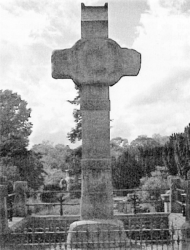
Dromore's High Cross. The inscription on
the shaft reads: "The ancient historical cross of Dromore.
Erected and restored after many years of neglect by public
subscription to which the Board of Public Works were
contributors, under the auspices of the Town Commissioners
of Dromore, County Down, 21.D.1887."
A valuable relic from this period is Dromore's High
Cross which can be seen today encased within the perimeter wall of
Dromore Cathedral, just beside the River Lagan. The cross comes from
well after the time of Colman and the parts of it which are original are
reckoned to be 9th. or 10th. Century. The cross is of granite and may
well have been originally enclosed within the grounds of the Dromore
monastery. The lower part of the shaft is considered original and bears
some fretwork designs framed by interlace panels. The upper part of the
shaft is modern, but it supports the cross' ancient head which has an
imperforate ring, characteristic of many Celtic crosses of the period.
The cross is believed to have formerly stood in the Market Square in
Dromore. It may have been removed to facilitate the building of the
original Market House in 1732. A part of the original shaft is said to
have been used in the construction of the stairway of that Market House.
The original base of the cross apparently became a foundation for the
infamous Dromore Stocks in the early years of the nineteenth century.
The remaining parts of the ancient monument lay neglected at the south
west corner of the Market House. The present Market House of Dromore was
built in 1886. Following its completion, the remaining parts of the
cross were retrieved and reconstructed in their present location in
1887.

The introduction of dioceses to Ireland, which came
as part of a process of reorganisation and renewal in the twelfth
century, ultimately led to the decline in authority and ecclesiastical
importance of monasteries such as Dromore. Successive Archbishops of
Canterbury had expressed their concern at the lack of Episcopal
organisation in Ireland and a reform party was established within the
Irish Church with a view to adapting the Gaelic Church to the structures
already in existence throughout much of Europe. A synod, held at
Rathbreasail in 1111, divided the country into separate dioceses with a
bishop, accountable to Rome, at the head of each. These divisions were
refined and altered where necessary at a further synod at Kells in 1152.
Whatever state it was in, the church centred on or
emanating from Dromore must not have appeared particularly significant
to these medieval reformers as it did not feature in the conclusions of
either of these synods and was included for the most part, we presume,
in the diocese of Down. Evidence of a distinct diocese emerging for
Dromore comes, however, through the inclusion of a certain O'Rooney,
described as `Bishop of Iveagh', among the signatories to a charter of
St. Malachy, around the year 1190, while the latter was Bishop of Down.
The use of the title `Dromore' indicating an actual diocese first
occurs, we believe, in 1197 and it is very possible that it was created
at a minor synod held by the papal legate, at Dublin, in 1192. The
territory which the new diocese comprised would have greatly extended
beyond the lands of Dromore monastery. The diocese coincided to a
considerable degree with the lands of the Magennis clan, Lords of Iveagh
or the ancient kingdom of Ui Eachach Cobha, who rose to power in the
later twelfth century. (Hence, presumably, O'Rooney's being described as
Bishop of `Iveagh' in 1190). Disputes between the Magennis clan and
their local gaelic rivals, the MacArtans, had unsettled the region and
likely troubled Dromore monastery for generations. Gradually enjoying an
ascendancy in the later medieval period, the Magennis clan established
their power centre at Rathfriland and their lands provided a kind of
buffer between the powerful O'Neills to their west and Normanized east
Down, to their right - diocesan boundaries having to take account of the
political realities of the day!
Dromore Diocese, then, came into being as largely
Gaelic territory, unpenetrated by the Anglo-Norman incursions of the
period. The town which would have grown up around Dromore monastery
would have almost been a gateway between the Gaelic arid the Norman
worlds of that region. Small wonder, then, that an important Norman
defence post was located overlooking Dromore and the lands beyond. The
motte and bailey, which followed John de Courcy's successful conquests
in east Ulster in the later twelfth century, was among the more
significant defence earthworks constructed by the Normans in Ireland and
would have housed a permanent garrison. The well preserved remains of
this motte and bailey are an attractive historical feature of Dromore
town today.
The establishment of dioceses and the gradual
movement of power from local abbot to local bishop was not the only
process of reform effecting twelfth century Irish Christianity and
monasticism. Reform of monastic life itself was also a feature of the
European Church of the period. The reformed Cistercian rule of St.
Bernard of Clairvaux, on the continent, greatly influenced the
Armagh-born St. Malachy, Bishop of Down and Connor and later Archbishop
of Armagh. Malachy met St. Bernard in Rome in 1140 and left some of his
monks in Bernard's charge, so that they could be trained according to
the new Cistercian ways. These in turn, with French assistance, helped
to found a great Cistercian abbey at Mellifont in Louth. A monastery
previously established at Newry accepted the Cistercan Rule in 1144 and
continued to prosper as a daughter house of Mellifont until Reformation
times. It was closely associated with the Magennis clan.
THE MONASTERY DECLINES
The Normans in Ulster were, themselves, enthusiastic
about the development of monasticism. De Courcy and his relatives were
instrumental in establishing and assisting a number of religious houses
within their territories, such as those at Greyabbey (1193) and Comber
(1200), both Cistercian. Given the reformed zeal of these new
foundations and their often powerful patrons, it would be easy to
imagine how older, unrenewed religious houses such as Colman's Dromore
could have been eclipsed in the `reformed' Irish Church of the period,
and forced into permanent decline. So the monastery of Dromore fell
silent, it seems, as the diocese of Dromore took shape. Whatever church
succeeded the monastery, in Dromore Parish itself, would have continued
to enjoy a prominent position as the Cathedral church within the local
diocese. The diocesan bishop, in the reformed arrangement, would have
been the official pastor of the parish of Dromore while other clergy,
delegated under his authority, would have actually met the day to day
pastoral and spiritual needs of the parishioners. A Cathedral Chapter of
Dromore is first mentioned in documentation in the 1240s following the
death of the then Cistercian bishop of the diocese. A controversy arose
as the Cistercian Abbey at Newry claimed to be the Cathedral of the
diocese with the right, therefore, to appoint the new bishop. The
Chapter of Dromore contested that they were the proper body responsible
for episcopal elections. The Primate ruled in favour of Dromore
Cathedral Chapter and this decision was, in turn, approved by Rome.

POOR DROMORE
Dromore was one of the smallest, least significant
and poorest dioceses in Ireland. Probably because of this, we have
little enough information recorded about it in the period between its
establishment and the Protestant Reformation of the sixteenth century -
the less `important' generally receiving less attention! While
information on the succession of bishops is not complete, we have a fair
idea of the character of the Dromore episcopacy towards and throughout
the later Middle Ages with its mix of Irish and Anglo-Norman blood. By
the fifteenth century, leadership of the diocese had come to be largely
in the hands of absentee English ecclesiastics or, for periods of time,
apparently vacant altogether. One reason for this may have been an edict
issued by England's King John, in 1217, forbidding the promotion,
ecclesiastically, of the native Irish. England's insistence that it knew
best for Ireland and the Church in Ireland is a regular theme in
medieval history and one that appeared to often find a sympathetic
audience in Rome. The other obvious reality was the undesirability of
Dromore because of its relative poverty. The Archbishop of Armagh,
writing to Henry VII in 1487, remarked that the revenues of the Dromore
Diocese amounted to a mere forty pounds annually and seemed to suggest
that this was the reason why "none would remain upon the bishopric." By
the late fifteenth century Dromore, in fact, even had bishops of French
and Greek origin! Given this general background, it is hard to imagine
that the local church in Dromore reached the era of the Protestant
Reformation in a state of either high morale or healthy order.


The Cathedral Church of Christ, the
Redeemer, is believed to occupy the site of the
pre-Reformation monastery. Within the cathedral an ancient
stone is displayed, with a cross engraved on it. It is known
as 'St. Colman's Pillow'.
The controversial Arthur Magennis was Bishop of
Dromore ( 1540-1573) as the Reformation began to be felt throughout the
Irish Church. Magennis' acceptance of a `royal pardon' in 1550 and his
swearing that he would hold his bishopric from the English Crown have
raised serious questions about the orthodoxy of his later years. The
Cathedral at Dromore did, however, fall to the Reformers in this period
and a first Anglican Bishop of Dromore was, in turn, appointed in 1606.
This bishop, John Todd, was a former Jesuit priest who later resigned
his position, in 1611, and committed suicide while imprisoned in London.
On Todd's appointment to Dromore, his brother-in-law, William Worseley,
built a castle in Dromore for his protection. The remains of this castle
can still be seen in Dromore town today. During Bishop Todd's tenure, in
1609, King James I issued a charter changing the title of Dromore
Cathedral from `Ecclesia Sancti Colmani' to 'Ecclesia Christi
Redemptoris de Dromore', that is from St. Colman's Cathedral to the
Cathedral Church of Christ, the Redeemer. This new title is still borne
by the Church of Ireland Cathedral in Dromore today. James I endowed the
See of Dromore with extensive new properties in the area so as to
rapidly enhance its revenues and ordered the reconstruction of the
Cathedral. From this evidence, and from what has been remarked earlier,
it would seem safe to conclude that whatever edifice had been inherited
from the medieval era, Dromore's Cathedral was not in a very solid state
by the beginning of the seventeenth century. Bishop Theophilus Buckworth
eventually succeeded Bishop Todd and began the reconstruction work in
1613. He commented in 1622 that the Cathedral was "almost new
building, covered, glassed and in part furnished with seats." From this
it is difficult to determine to what extent any of the older building
may have been incorporated into the new. The "almost new building" might
suggest some carryover from before. On the other hand, it may be merely
referring to an entirely new building project not yet complete.
Buckworth went on to undertake the construction of a Bishop's Palace in
the vicinity of Dromore but had not yet completed it when rebels struck
at Dromore in 1641. The unfinished palace, the rebuilt Cathedral and
town of Dromore were heavily damaged as a result of this assault. The
Cathedral had to wait for restoration until the episcopacy of the famous
Anglican divine Jeremy Taylor. He had it rebuilt between 1661 and 1667
and, following his wishes, his remains were interred within the restored
Cathedral. Dromore Cathedral was to have another major renovation and
reordering in the 1770s and it was only after further extensions in 1870
and 1899 that it acquired the appearance which it has today. A new
Bishop's Palace was begun by Bishop William Beresford in 1781 and
completed by his successor Bishop Thomas Percy. It eventually became
known as `Dromore House' and was to be used, a century later, as a
novitiate by the Society of Jesus.

Following the Protestant Reformation of the sixteenth
century and the subsequent plantation of English and Scottish settlers,
the population of the area corresponding to the parishes of Dromore and
Garvaghy found itself with a substantial majority of Protestants, within
which group Presbyterians were the largest denomination. As the
Cathedral Church in Dromore fell to the emerging Anglican communion, so,
too, whatever place of Christian worship existed within Garvaghy Parish
would also have been given to the new creed. The Catholic people of
these parishes, like their co-religionists in so many places, were to
experience the consequences of Reformation legislation and, in time, the
severities of the Penal Laws.
Three Mass Stations are recorded from penal times in
this area. There probably were a number of others. An ancient rath or
fort existed on land which later came to be included in the demense of
the new Protestant Bishop's Palace. Mass was celebrated here, causing
the site to become known locally as `Dromore Mass Forth'. The
aforementioned Bishop Percy allowed the celebration of Mass to continue
after he moved to live on this estate in the middle of 1782. Later that
same year, he granted a site for the erection of a small Catholic Mass
House on the edge of the town. It was close to the site of the present
St. Colman's Church which, in time, superseded it. Within the townland
of Edentrillick, on the Ballynahinch side of Dromore, a Mass Rock is
said to have existed. It was located about two and a half miles from the
town and was apparently damaged by quarrying operations in the area over
a century ago. A `Mass Bush' located in the townland of Ballela is
believed to have been cut down early in the last century. It was sited
on land belonging to the McAnarney family, about 250 yards from the
location of the present cemetery in Ballela.
Within the archives of the Irish Franciscan Province,
in Killiney Co. Dublin, there is reference to a foundation in Dromore
during the Penal period. It suggests that a Franciscan Religious House
or some form of community was established in the area around the year
1690. Evidence of its activity is scant, though the Chapter Acts of
Irish Franciscans list `Guardians of Dromore' until the year 1776.
These references to the appointment of `Guardians' may simply have been
a formality. After Religious Houses were suppressed in Penal times,
their Orders or Congregations often continued to appoint superiors
officially in the hope of re-establishment in better times. On the other
hand, even if an actual Religious House did not exist, or had ceased to
exist, the appointment of a superior might have been an acknowledgement
that members of a religious community were carrying out some kind of
organised ministry in a locality without any obvious structures or
public trappings. With regard to the presence of Irish Franciscans at
Dromore, either possibility could have been the case. It was held by
certain locals, in the past, that a Franciscan House did actually exist
in the town on the site later occupied by Dromore railway station.
From the information contained in the Franciscan
archives, the following list of `Guardians of Dromore' has been
compiled. Because some papers were lost in former times, on their way
abroad to Louvain, the list is incomplete. Though the years 1717-51 are
not covered here, there is no reason to suggest that `Guardians' were
not appointed during these years:
1690, Pater Frater Antonius Magnesius (Magennis)
1693, Paulus O'Brin
1697, Paulus Bern
(perhaps the same as preceding name)
1699, Philip Runy (Rooney)
1700, Dionysius Maghee
1702, Patricius Kiernan
1703, Patricius Kiernan
1705, Paulus Brune
(probably the same as in 1693, 1697)
1706, Jacobus Shiell
1711, Jacobus Shiell
(as in 1706; he became Bishop of Down and Connor in 1717)
1714, Patricius Kiernane (probably the same as in
1702, 1703)
1716, Patricius MacKiernan
(probably the sanie as above)
1717, Jacobus Kennedy
1751, Dionysius Timony
1759, Joannes MacLaughlin
1761, Felix Cullen
1770, Maguire
1772, Peter MacLaughlin
1773, Antonius Dogherty
1776, Joannes Reilly
A John Barton is named as `Guardian of Dromore' in
1785, by Fr. Brendan Jennings O.F.M., in an article in the Irish
Ecclesiastical Record of February 1951 .

By the time the Catholic Church began to assert
itself more publicly in Ireland, in the second half of the 1700s,
significant population shifts and other consequences of plantation and
emigration had occurred. This meant that new ecclesiastical structures
were needed to address a milieu rather different from the world of the
pre-Reformation Irish Church. Medieval parochial boundaries had
gradually become blurred and, in Penal times, such priests as managed to
minister often did so across a range of local parishes. In the
`post-Penal' era, Garvaghy Parish effectively ceased to exist as a
separate entity and was united with the much larger parish of Dromore.
The seat of the Dromore Diocese transferred to Newry in this period. It
was developing as the largest centre of Catholic population within the
area covered by the diocese. The new Catholic Cathedral was begun there
in 1823 and opened in 1829. Over the following decades, a number of
religious houses were established in Newry and a Diocesan College was
founded there. Although of considerable historical significance, the
town and parish of Dromore no longer played a central role in the life
of the diocese.
ST. COLMAN'S CHURCH, DROMORE.
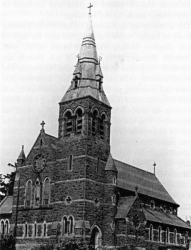
St. Coleman's Church, Dromore, was
built 1871-73. It replaced an earlier Mass House which
had been in use since 1782.
The present, majestic Parish Church of Dromore
replaced a much smaller Mass House which, as mentioned earlier, had been
built on a site granted by the Church of Ireland Bishop Percy, to
provide for those who were attending the `Mass Forth' on his demense.
The older building was located about thirty yards to the south of the
present church. Fr. Edward Greenan P.P. had overseen the building of it
in 1782. This church was substantially renovated in 1829 at a cost of
�350. The planning of the present Church of Saint Colman began forty
years later. The foundation stone was laid by the Dominican Bishop of
Dromore, Dr. Leahy, on 27th. October 1871. The sermon was preached on
this occasion by the new Irish Primate, Archbishop Daniel McGettigan,
who later was responsible for the completion and dedication of St.
Patrick's Cathedral, Armagh. Fr. William McCartan, who had been
appointed Parish Priest in 1859, directed the building project. He had
previously had a new school house erected nearby and was determined that
the town of Dromore should have a Catholic church worthy of a place so
important in ecclesiactical history. A building fund for the new church
was established which, in addition to the contributions of Dromore and
Garvaghy parishioners, drew support from among local Protestant people,
other Catholic parishes in the Dromore Diocese and Dromore emigrants in
the United States and elsewhere. Fr. McCartan himself toured England and
Scotland in order to raise funds for the building.

The architect for St. Colman's Church was Timothy
Hevey of Belfast and it was designed after the style of early English
Gothic. Built in black stone, with freestone dressings, the walls of the
church are externally supported with courses and buttresses. The church
consists principally of a nave, with two side aisles and dividing
arches. A fine square tower and spire were included in the original
building - the main entrance to the church, a recessed door with an
impressive hooded moulding, being located at the base of this tower. On
approaching the church, a fine rose gable window is to be seen,
dedicated to the Sacred Heart and, below it, windows in honour of Our
Lady and St. Bernadette. A niche, intended for a statue, rather sadly
remains vacant. The original High Altar and sanctuary lamp of St.
Colman's were the gift of Charles Devlin of New York, a former Dromore
parishioner. Devlin also donated a gold chalice to the new church.
Sanctuary windows depict the risen Christ and several of the early Irish
saints. Alongside the main sanctuary two side altars are included,
originally dedicated to Our Lady and to St. Joseph. Along the higher
reaches of the nave are painted images of Saints Patrick, Colman,
Columbanus, Finbar, Columcille and Malachy. Latticed windows throughout
the church allow it to enjoy what might be called a `shattered light'. A
stone tablet, dedicated to the memory of three previous priests of
Dromore, was erected just inside the main entrance to the new church on
its completion. It recalls two Parish Priests, Fr. Hugh McConville and
Fr. John Sharkey and curate Fr. James O'Neill. These priests had
previously been honoured by memorials in the old church and their memory
was maintained in the new. In later years a memorial was placed in St.
Colman's in honour of Monsignor McCartan himself. It declares him to
have been "almost 51 years the zealous pastor of Dromore and Garvaghy,
beloved by his own, revered and respected by all classes of the
community." On his death, on 13th. March 1907, Monsignor McCartan's
remains were interred within St. Colman's Church. So he is still
recalled in the church he took pride in building.
After a period of two years in construction, St.
Colman's Church was completed in the autumn of 1873 at a total cost of
almost �17,000. It was officially opened and dedicated on Sunday 28th.
September 1873. The ceremony was attended by many of the leading
Catholic figur�s of the time including Archbishop McGettigan of Armagh,
Bishop Donnelly of Clogher and Bishop Dorrian of Down and Connor. The
Bishop of Dromore, Dr. Leahy conducted the Dedication ceremony and the
sermon was delivered by Rev. Thomas Burke, a prominent Dominican
preacher at that time. The Banbridge Chronicle of October 4th. 1873, offered its readers a flavour of the
sermon:
"The Rev. Preacher further referred to the
architectural beauties of the building, showed how consonant they
are with the spirit of true religion, pointed out how in them also
was proved the fulfilment of God's promises to His Church and
concluded an eloquent discourse by a sympathetic appeal to the
charity of the congregation, in the following words: "I need not say
a word to you to stir up your charity and devotion to your good
pastor, who has devoted his days and nights to the raising and
ornamenting of this beautiful church. I know you will bear him
manfully through his difficulties. The Son of God, not complaining,
yet observing, said "The foxes have holes and the birds of the air
have nests but the Son of Man hath no place whereon to lay his
head." Arise, ye men of faith, everyone who believes in Jesus
Christ, who would be fain to show their love for Him - arise and
wipe away that reproach by your action this day. Show to Our Divine
Master that it shall no more be said He hath no place where to lay
His head."
The music for the ceremony was provided by the choir
of Newry Cathedral under the direction of the Cathedral Organist, Mr.
John Russell. The master of ceremonies was Very Rev. Dr. Thomas
MacGivern, Parish Priest of Drumgath and later Bishop of Dromore. A
collection was taken up from the congregation, amounting to �985. A
luncheon, following the ceremony, was provided in the adjoining school
house.
St. Colman's Church has undergone a variety of
renovations and modernisations through the years, especially in 1927 and
1932, and in the aftermath of the Second Vatican Council. A new set of
Stations of the Cross were erected in 1924. They had been donated in
memory of Annie Creney who is buried in the cemetery adjoining the
church. There were, however, no extensions to the church from 1873 and
any work undertaken appears to have respected the original character and
design of the building. Of special significance was a partial reordering
of the sanctuary undertaken in 1992/93, under the direction of the
Parish Priest Fr. Gerard Conway. A new altar, lectern and president's
chair were installed using a tasteful mix of stone and marble which
echoed the original architect's choice. The side altar in honour of St.
Joseph became a baptistry with a new baptismal font. Artwork of coloured
glass, encased in copper, adorns the new furnishings in the renovated
sanctuary. Striking, still, is the original reredos which holds the
tabernacle and depicts some scenes from the Old Testament. Beautifully
lit today, it enables St. Colman's Church to maintain a gentle
continuity between the old and the new. The church also had its
congregational seating renewed.

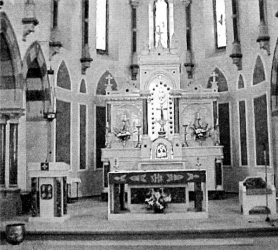
The beautiful sanctuary of St.
Colman's Church, as it is today. The sanctuary was
extensively renovated 1992-93. It was restored, again,
in 1994 following a second arson attack on the church.
Dromore Church was close to being reopened when it
was tragically attacked by arsonists on the night of Monday 6th. January
1993. Following expensive repair and eventual completion of the
renovation project, the church was rededicated by Bishop Brooks on
Sunday 28th. November 1993. Sadly it was to be attacked again on the
night of Sunday 27th. March 1994. This time �30,000 worth of damage was
caused after petrol was poured through windows and a fire started.
Fortunately the local Methodist Minister, who lived nearby, raised the
alarm and helped save the church from being gutted. Fr. Conway,
supported by his parishioners, again worked hard to make good the harm
that was done. In between the attempted burnings of the church, a fire
attack was also made upon the Parochial House in Dromore, in July 1993.
Fortunately no injuries resulted and the house was subsequently repaired
by Fr Conway. The following year a newly opened church in Ballela was
firebombed. Later, in July 1998, the Parochial House in Dromore was
attacked again and the garage adjoining it was destroyed by fire.
Sectarian attacks upon the Catholic community and
Catholic clergy in Dromore are not a new phenomenon. Back in 1798, a mob
attacked the Parish Priest Fr. Andrew Murnin as he made his way through
the town one evening. They attempted to hang him from a tree near the
Cathedral and he only escaped when a prominent local Protestant, the
agent for the Church of Ireland Bishop of Dromore, intervened and cut
him free. More recently Fr. John O'Hare, who was
Parish Priest from 1907 until September 1920, had the
new Parochial House which he built in 1911 attacked a number of times.
Mobs actually drove him out of the house on two occasions and,
overwhelmed by it all, he left Dromore for a new parish in 1920.
1920 was a particularly dreadful year of
anti-Catholic sentiment in Belfast and other towns in east Ulster.
Following the annual Orange demonstrations in July that year, Catholics
found themselves frequently evicted from work in mills and factories.
Banbridge town saw the funeral on 21st. July of Colonel G.F.Smyth a
police divisional commissioner who had been shot dead in Cork a few days
earlier. Attacks on Catholic homes and businesses followed his funeral
that evening, in both Banbridge and Dromore. Several Catholic families
were intimidated from Dromore at this time and, in time, made new homes
in Newry and in other areas of south Down.

ALL SAINTS' CHURCH, BALLELA
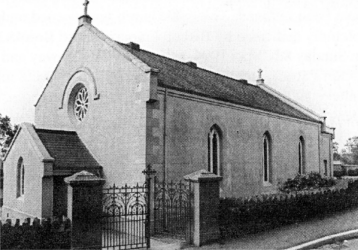
The former All Saints' Church
served the Ballela community from 1822 until
1994.
It is believed that an old Mass House existed at
Ballela, from around 1770, on the site of the original All Saints'
Church. The construction of this latter church was begun during the
pastorate of Fr. Hugh McConville P.P. in the year 1822. Substantial
assistance in this building project was given by the local landlord,
Roger Magennis of Ballooley House. The building, with a small cemetery
to the rear, was further extended, re-roofed and eventually completed
during the years 1846-49, under the direction of Fr. John Sharkey P.P.
It was dedicated to `All Saints' by Bishop Michael Blake on 20th. May
1849. The Mass of Dedication was celebrated on this occasion by Fr.
Patrick McNulty and the special preacher was Fr. Henry O'Loughlin of
Belfast.
All Saints' Church was thoroughly renovated, raised
in height, and the sanctuary reordered by Fr. James Murney P.P. in 1950.
The architects were McLean and Forte of Belfast. A simple rectangular
edifice, All Saints' Church now had a new High Altar in marble, with a
canopy overhead supported by stone columns. An altar to Our Lady
occupied one side of the sanctuary while the other, adorned by a large
statue of the Sacred Heart, formed a passage to the sacristy area. New
sanctuary railings, also in marble, were installed. New Stations of the
Cross were erected, very distinctively sculpted, each with gaelic
inscriptions below. These were later transferred to the new All Saints'
Church, where they can still be seen. The windows were also enlarged in
the 1950 work and new seating, heating and lighting were put in place.
The renewed church was rededicated and reopened by Bishop Eugene
O'Doherty on 24th. September 1950. Solemn High Mass to mark the occasion
was celebrated by Fr. Emmet Devlin, the curate in Ballela at that time.
The sermon for the reopening was preached by Fr. Edward Campbell, the
Administrator of Newry Cathedral. Fr. Campbell referred to
the historical associations of the parish and appealed to the
congregation to contribute generously towards the reconstruction work.
At the end of the ceremony Bishop O'Doherty dedicated the new Stations
of the Cross and gave Solemn Benediction.
All Saints' Church served the Ballela area well for
172 years. It needed replacement, however, by the end of the twentieth
century and the construction of a new church was undertaken, under the
direction of Fr. Gerard Conway P.P., in 1993. The new All Saints' Church
enjoys an elevated site overlooking the remains of the old church and
the cemetery around it. It has grounds which are impressively landscaped
and well maintained. The new church was designed by McClean and Forte,
the same architects who had worked on the renovation of the old church
in 1950. The builders were McCartan Brothers of Lawrencetown. The church
is rather novel in design, its hexagonal and triangular windows being
particularly distinctive. The altar, lectern and president's chair are
in marble and a fine piece of copper artwork depicts a scene from the
ministry of St Patrick. The Stations of the Cross from the old church
have been retained. The new church was opened and solemnly dedicated by
Bishop Francis Gerard Brooks, on Sunday 8th. May 1994, assisted by Fr.
Conway and Canon Patrick Smyth, who was the resident curate in Ballela
at the time. Following the opening of this splendid new church the old
All Saints' Church was demolished. More recently, in April 2001, within
the foundations of the old church the remains of Fr. Seamus Reid were
laid to rest. Fr. Reid had served as curate in Ballela from 1977 until
1981 and had later retired there.
Sadly the new church in Ballela also became the
object of sectarian attack. It was firebombed just a few months after
opening, on the night of Monday 22nd. August 1994. As well as severe
smoke and floor damage, the altar of the church was considerably harmed.
With the necessary repairs and restoration work carried out, at a cost
of �70,000, the church was reopened and a new altar dedicated by Bishop
Brooks on the evening of Thursday 8th. December 1994. That same year,
not far from Ballela, another rural Catholic church was attacked at
Drumnavaddy, close to Banbridge. Attacks on churches, of various
denominations, have unfortunately continued to be an aspect of Northern
Irish life in recent years, especially at times of communal tension.

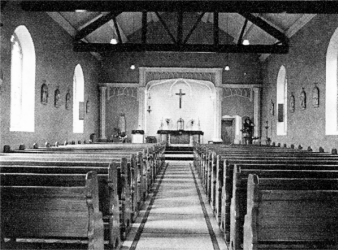
The interior of the former Ballela
Church. Bishop O'Doherty had rededicated the
sanctuary in September 1950.
For about a century after the emergence of the church
from Penal days, the various pastors who served in Dromore and Garvaghy,
as in other parishes, would have lived in lodgings or temporary type
accommodation in the locality. This continued until around the middle of
the nineteenth century when substantial Parochial Houses began to appear
across the country. A house for priests was built in Dromore town, close
to the old Catholic church there, sometime during the period when Fr.
John Sharkey was Parish Priest (1844-59). It was superseded by a new
Parochial House, on the edge of the grounds of St. Colman's Church,
which was built in 1911 while Fr. John O'Hare was Parish Priest. A
curate's residence had been built, in the meantime, to the rear of the
church at Ballela. It was replaced by a new curate's house, on a site
almost opposite the church, in 1927. Fr. Michael O'Hare became the first
curate to occupy this new residence, on 7th. July 1928. During his early
years in Ballela, he oversaw the erection of a Parochial Hall near to
where the new curate's house was built. This hall has served the local
community in Ballela throughout the twentieth century. It had a major
renovation in 1986 and was reopened on Sunday 8th. March 1987.
The oldest part of the Catholic cemetery in Dromore
town is believed to be contemporary with the original church there
(1782). A new portion was added and this was blessed by Bishop Blake on
18th. September 1848. The new St. Colman's Church (1873) was built
within this cemetery.
At Ballela, the oldest part of the present cemetery
is considered to be contemporary with the old church there (1822). The
cemetery was extended in 1849 and this new burial ground was blessed by
Very Rev. William O'Brien, Parish Priest of Lurgan, on 31st. January
1850. A much older cemetery, used by local Catholics, existed in the
nearby townland of Shanrod.
According to Ordnance Survey records, a National
School, (forerunner of the primary school), existed at Ballela, in 1837.
It was housed in what was described as "a small cottage," with 100
Catholic and 10 Presbyterian pupils. The school was visited by the
Parish Priest, Fr. Hugh McConville. Catechism was taught on Saturdays
and, apparently, scripture lessons also. The school had been established
in December 1834 and the Mistress was a Catholic named Margaret Watson.
In Dromore town, the Parish Priest and the
Non-Subscribing Presbyterian Minister were visiting the National School
in 1837. It was divided into separate accommodation for boys and girls
and had been established in 1833. Of the roll in 1837, there were 20
Catholic girls out of a total of 66 and 16 Catholic boys out of a total
of 64. The Master and Mistress were both Presbyterian.
A new school was built in the townland of Shanrod in
1858 and opened in 1859. It was extended in 1861. It was to become the
Catholic school for the Ballela area for several generations. In
Dromore, a new Catholic school was erected in 1862 shortly after Fr.
William McCartan became Parish Priest. It was located
within the grounds of the Parish Church, which was soon to be replaced
by the present St. Colman's Church. When the new church was opened in
1873, the new school house hosted a reception for guests afterwards. The
Dromore town school continued to educate boys and girls separately.
Statistics from Dromore Diocesan Religious Education Schools'
Inspections, documented from the 1920s onwards, give us a picture of the
school population patterns in the parish. In 1926 Dromore had 60 girls
and 59 boys in school, while Shanrod had a combined total of 62. By
1939, Shanrod had fallen to 47, while in Dromore town there were 63 boys
and 51 girls. By 1951 boys and girls had combined in Dromore town,
giving a total of 130 pupils. Shanrod, in that year, had 82 pupils. This gave a total
primary school roll within the parish of 212 children, at a time when
the overall population of Dromore Parish was slightly in excess of 1200
people.
The 1950s were to herald a new era in education in
the North of Ireland. Post-Primary Education for all became a feature of
life for young people and as Secondary Intermediate schools came to be
built, such as St. Patrick's Banbridge in 1957, so the character and
range of primary school education changed as well. Many new
purpose-built primary schools began to appear across the country in the
1960s. The old schools at Dromore and Shanrod were replaced at this
time. Dromore's new St. Colman's Primary was sited alongside the old
school, at the edge of the church grounds. It's architects
were McClean and Forte of Belfast and it was built by Grahams of
Dromore. It opened on 1st. September 1969. A new school was opened the
very same day at Ballela. All Saints' Primary was located between the
curate's house and the Parochial Hall. It was also designed by McClean
and Forte and was built by Blaney Brothers of Downpatrick. The old
school premises in Dromore town were reconstructed as parish function
rooms.

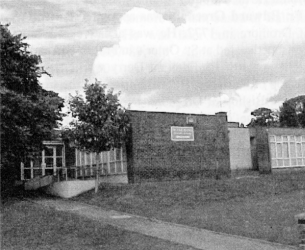
Dromore's Catholic Primary School,
dedicated to St. Colman (above), and All Saints' Primary
School, Ballela, were both opened on 1st. September
1969.
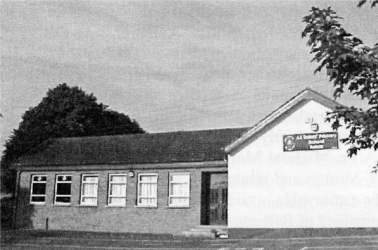
POST-REFORMATION PARISH PRIESTS OF DROMORE
Fr. Murtagh O Lawry (O'Lavery), was registered
at Downpatrick on July l lth., 1704 as Parish Priest of Magheralin and
Dromore. He was previously outlawed by the Williamites in October 1691.
He is stated in 1704 to be 53 years old, residing in Magheralin and as
having been ordained in 1673 by the Bishop of Down and Connor, Dr.
Daniel MacKey. He was said to be a native of Magheralin.
Fr. Hugh Sheile (Shields), was also registered
at Downpatrick in 1704 as being Parish Priest of Magherally and Garvaghy.
He lived at Corbet, was aged 50, and had also been ordained by Bishop
Mac Key in 1674. He had also been outlawed by the Williamites,
apparently while Parish Priest of Drumgooland, in October 1691.

A Fr. Downey is described as Parish Priest of
Dromore, Magherally, Seapatrick and Garvaghy and Magheralin in 1720.
A Fr. Lavery is mentioned as Parish Priest of
Dromore and Magheralin in 1738. He may well have been the Fr. Murtagh
O'Lawry mentioned above. He was reputed to be, at this time, a good
friend of Lord Moira. He died around 1770, apparently at a great age.
Fr. Edward Greenan, was appointed Parish
Priest of Dromore in 1772. He was a native of Clonduff Parish, educated
at St. Omer's in France and had been a classmate of Fr. Edmund Derry who
later became Bishop of Dromore. He was a friend of the Church of Ireland
Bishop of Dromore, Dr. Percy, who gave the site for the old Catholic
Church in Dromore. Fr. Greenan would have been responsible for the
erection of this church in 1782.
Fr. Andrew Murnin, a native of Clonduff, took
an oath of loyalty at Downpatrick on 5th. September 1782 where he
described himself as "priest of the Diocese of Dromore." In 1783 he was
curate in Dromara and Magheradroll and sometime later that year became
Parish Priest of Dromore. In 1793 he is described in the Catholic
Qualification Roll as "Titular Rector of Dromoregh" (Dromara). In
1798, Fr. Murnin had a harrowing experience when he was set upon
by a mob in the town of Dromore and was suspended, by them, from a tree.
Apparently a Mr. Crane Brush, agent for the Church of Ireland Bishop,
heard the commotion and ran to his rescue, cutting Fr. Murnin free with
a razor with which he had been shaving. He maintained guard until Fr.
Murnin could be safely taken away. Fr. Murnin was said to have left the
parish shortly after this experience.
A Fr. Michael Morgan appears to have succeeded
Fr. Murnin and ministered in Dromore at the turn of the century. He is
said to have lived somewhere in the townland of Balleny.
Fr. Arthur McArdle was appointed Parish Priest
of Dromore in 1801. Fr. McArdle was a native of Ballyroney in the parish
of Annaclone. He was ordained in 1795 and later that year went to the
newly established Maynooth College to pursue theological studies. He
later studied at Carlow College. Fr. McArdle was a curate in Newry from
1799 to 1801, the year he was appointed to Dromore. He was a regular
guest of Bishop Percy's while in Dromore. The Protestant people of
Dromore apparently thought highly of Fr. McArdle and presented an
address to him, as a tribute, when he left for Aghaderg Parish in 1814.
Fr. McArdle later became prominent in diocesan affairs and enjoyed the
titles of `Archdeacon' and `Dean' at various stages. He died at
Loughbrickland in 1838.
Fr. James Moore was a newly ordained priest
when he was appointed Parish Priest of Dromore in 1814. Fr. Moore had
been educated at Maynooth College and ordained by the Bishop of Dromore,
Dr. Derry, in Newry in 1814. He was sent to Dromore following ordination
and remained there until 1821, when he became Parish Priest of
Magheradroll. During his pastorate in Magheradroll he resided in a house
in the townland of Magheratimpany. He died there in July 1826. Reporting
his death at the time, the Belfast News Letter remarked that "His
labours were incalculable and he was loved by his flock and respected by
every person of different persuasions." His remains were interred in the
church in Ballynahinch where a memorial describes him as "the revered
Parish Priest of Ballynahinch, Dunmore and Annahilt."
Fr. Hugh McConville was to succeed Fr. Moore
as Parish Priest in 1821. A native of Tullylish, he was born in 1782,
was ordained in 1809 and studied at Carlow College. He became Parish
Priest of Seagoe in 1809 and remained there until his appointment to
Dromore. Fr. McConville was responsible for the erection of the old
church at Ballela, begun in 1822. He was well regarded in the wider
community and addressed a gathering following the installation of a new
minister at the Non-Subscribing Presbyterian Church in Dromore in 1824.
Fr. McConville became Vicar General of the Dromore Diocese in 1836 and
later Dean of the diocese. He died on 16th. September 1844 and his
remains were interred in the old church in Dromore town. A plaque to his
memory was later transferred to the new St. Colman's Church, when it was
opened in 1873.
Fr. John Sharkey was appointed Parish Priest
on 19th. September 1844. A native of Newry, he was educated at Maynooth
and ordained by Bishop Michael Blake, in Newry, in 1833. He was curate
and later Administrator at Newry Cathedral, before going to Dromore. He
was responsible for the reconstruction of the old church in Dromore
town, in 1852, and for the provision nearby of accommodation for the
parish priest. Fr. Sharkey had also undertaken the renovation and
extension of the original church at Ballela, 1846-9, and the provision
of a curate's accommodation there. He died at Dromore on 17th. February
1859 and his remains were interred in the church there.

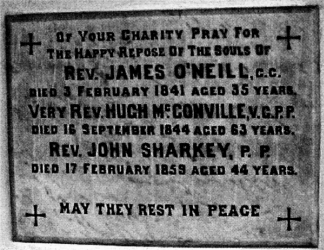
This memorial in the entrance porch of St.
Colman's Church recalls three priests who died in Dromore
and whose remains were interred within the former church
there.
Fr. William McCartan was appointed Parish
Priest of Dromore on 22nd. March 1859. A native of the Parish of Lower
Drumgooland, he was born on 15th. August 1830. He was educated first at
`Mr. Johnson's Academy' near Castlewellan and later at St. Colman's
College, Newry. Owing to ill health his studies were interrupted and he
entered the Benedictine College at Douay, Northern France, in 1849 and
the Irish College, Paris, in 1850. Apparently, a short time before his
ordination, the Bishop of Queensland offered to make him Vicar General
of his diocese, but he declined and was ordained for Dromore Diocese, by
Bishop Blake, on 22nd. September 1856. Fr. McCartan was appointed to
Dromore that year, as curate, and became Administrator in 1857, due to
Fr. Sharkey's infirmity. He became Parish Priest after Fr. Sharkey's
death. Fr. McCartan's great work was the construction of the new St.
Colman's Church in Dromore, opened in 1873. Although this cost around
�17,000, because of his fundraising ventures and tours abroad the debt
was reduced to �1,500 by 1876. In 1887 he was appointed Vicar Forane and
in 1894 Pope Leo XIII made him a Domestic Prelate with the title
`Monsignor.' He died suddenly, in Dromore, on 13th. March 1907. Cardinal
Logue was a close friend of Monsignor McCartan and Dr. Henry O'Neill,
who was Bishop of Dromore at the time of the Monsignor's death, had
served Mass for him as a schoolboy in Dromore. In the will of Miss Anne
Magennis of Ballooley House, Monsignor McCartan was named as sole
beneficiary. Some years later, a law case related to this estate opened
in the Four Courts in Dublin, in February 1917. One outcome of this case
was the establishment of the Dromore Clerical Provident Society, to help
provide for sick and retired diocesan priests.
Fr. John O'Hare, succeeded Monsignor McCartan
on 4th. June 1907. He was born at Knockanarney in the parish of
Donaghmore, educated at the Irish College, Paris and was ordained by
Bishop Leahy in Newry Cathedral on 18th. November 1877. Fr. O'Hare
served as curate in Aghaderg 1877-79, Drumgath 1879-91 and Newry
1891-1903. He was appointed Parish Priest of Dromara in January 1903 and
came to Dromore four and a half years later. Fr. O'Hare was responsible
for the construction of the present Parochial House in Dromore, in 1911.
In his later years in Dromore he suffered at the hands of local
loyalists and was twice driven from his Parochial House. Fr. O'Hare was
transferred to Seagoe as Parish Priest in September 1920. He became a
Canon of the Cathedral Chapter in February 1924 and died on 16th.
September 1934. Canon O'Hare was buried in Barr Cemetery.
Fr. George McCorry, succeeded Fr. O'Hare as
Parish Priest of Dromore on 23rd. September 1920. A native of Seagoe,
Fr. McCorry was educated at Maynooth and ordained there on 6th. July
1884. He served as curate in Dromore Parish, based at
Ballela, until August 1887. He was later curate in Upper Drumgooland
1887-89, in Annaclone 1889-98, Lurgan 1898-1904 and Clonduff 1904-20. On
appointment to Dromore as P.P., he became a Canon of the Cathedral
Chapter. Canon McCorry died in Dromore on 19th. January 1925 and is
buried in Dromore Cemetery.

Fr. Patrick Greenan, was appointed Parish
Priest of Dromore on 28th. January 1925. A native of Clonduff Parish, he
was educated at the Irish College, Rome and ordained in the Lateran
Basilica, Rome on 21st. February 1892. Fr. Greenan served as curate in
Magheradroll 1892-1903, Annaclone 1903-5, Drumgath 1905-13, Seapatrick
1913-17 and Lower Drumgooland 1917-25. Fr. Greenan was responsible for
the construction of the new Parochial House at Ballela in 1927. He was
prominent in the Gaelic Revival Movement. Fr. Greenan died at Dromore on
22nd. April 1931 and is buried in Dromore Cemetery.
Fr. Michael Francis Gallogly, succeeded Fr.
Greenan on 1st. May 1931. A native of Newry, he was educated at the
Irish College, Paris and ordained by Bishop O'Neill in Newry Cathedral
on 2nd. December, 1902. Fr. Gallogly was on the staff of St. Colman's
College, Newry 1903-21. A man of great learning, he was elected a
`Fellow of the Chemical Society of Ireland' in 1912. Fr. Gallogly was a
curate in Banbridge 1921-30 and in Clonduff 1930-31. Owing to failing
eyesight, he retired from Dromore Parish on 25th. February 1941.
Fr. James Murney, became Parish Priest the day
1-r. Gallogly retired. He was a native of Killowen, in Kilbroney Parish,
where he was born in 1890. He was educated at Maynooth College and
ordained there by Archbishop Harty of Cashel on 18th. June 1916. Fr.
Murney served as curate in Aghaderg 1916-20, Clonduff 1920-24 and
1932-41 and Drumgath 192432. In 1950 Fr. Murney was responsible for the
significant renovation and extension of the old church at Ballela. He
was appointed to the Cathedral Chapter in August 1951. Canon Murney left
Dromore on 11th. November 1952 and returned to Clonduff as Parish
Priest. He died there on 7th. January 1960 and was buried in Hilltown.
Dr. Michael O'Hare, was appointed to Dromore on
11th. November 1952. A native of Donaghmore Parish he was born on 18th.
September 1887. He was educated at the Irish College, Rome. where he was
awarded a Doctorate in Divinity. On 5th. January 1913, Dr. O'Hare was
ordained in the Church of St. Apolinaris in Rome. He served as curate in
Upper Drumgooland 1913-16, Kilbroney 1916-17, Annaclone 1917-23, Seagoe
1923-25, Mayobridge 1925-33 and Lurgan 1933-37. Dr. O'Hare was appointed
Parish Priest of Lower Drumgooland in February 1937. In April 1951 he
became Parish Priest of Clonduff. The following year he was transferred
to Dromore. Dr. O'Hare retired from Dromore on 8th. June 1964 and went
to live in Belfast where he carried out duties as chaplain to a convent
for several years. He died in the St. John of God Nursing Home, Newry on
14th. May 1974 and was buried in Dromore Cemetery.
Fr. Joseph O'Hagan, was appointed Parish Priest
on 15th. June 1974. A native of Glasgow, he was educated at St. Colman's
College, Newry and at the Irish College, Rome. He was ordained at the
Lateran Basilica in Rome on 7th. March 1936. Fr. O'Hagan ministered in
Glasgow 1936-39, in Ballynahinch 1939-40, Warrenpoint 1940-41, Aghaderg
1941, Lurgan 1941-55 and Ballynahinch 1955-64. He became a member of the
Cathedral Chapter in February 1972. Canon O'Hagan celebrated the happy
occasion of his Golden Jubilee as a priest with Mass in Dromore Church
on 7th. March 1986. He retired from Dromore on 30th. August 1987. Canon
O'Hagan has continued, in his retirement, to serve as a curate at Cabra,
in the parish of Clonduff.
Fr. Malachy Finegan, served for a short period as
Parish Priest of Dromore, from August 1987 until January 1988. A native
of Newry, Fr. Finegan was educated at St. Colman's College and at
Maynooth. He was ordained in Maynooth College by Archbishop John Charles
McQuaid of Dublin on 21st. June 1953. He served temporarily in the
Diocese of Kildare and Leighlin, at Mountmellick Co. Laois, 1953-56. He
returned to the diocese and had appointments to Warrenpoint 1956-59,
Derrymacash 1959-67, St. Colman's College 1967-71 and Newry 1971-73. Fr.
Finegan returned to the staff of St. Colman's College in the autumn of
1973 and became College President in January 1976. He came to Dromore
eleven and a half years later. Fr. Finegan was transferred to Clonduff
as Parish Priest on 17th. January 1988. He retired in September 1995 and
died in Newry on 15th. January 2002. Fr. Finegan was buried in
Warrenpoint.

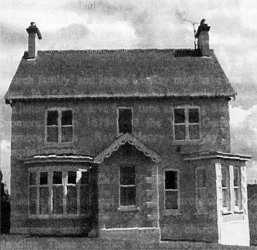
The imposing Parochial House at
Dromore. It was built in 1911 while Fr. John O'Hare
was Parish Priest.
Fr. Cathal Jordan, was appointed to Dromore as
Parish Priest on 17th. January 1988. A native of Scariff, Co. Clare, he
was educated at the Irish College, Rome and was ordained in Rome in
March 1959. He was appointed to Seagoe in 1959, Saval 1959-65, Newry
1965-66, Magheralin 1966-68, Newry 1968-81 and Lurgan 1981-88. Fr.
Jordan ministered in Dromore until 15th. August 1990, when he was
transferred to Seagoe as Parish Priest. He became a Canon of the
Cathedral Chapter in June 2000.
Fr. Gerard Conway, was appointed Parish Priest of
Dromore on 15th. August 1990, in succession to Fr. Jordan. A native of
Killeavy, Co. Armagh, he was educated at St. Colman's College, Newry and
at St. Kieran's College, Kilkenny. He was ordained in 1956 and went to
work in Scotland, in the archdiocese of Edinburgh. Fr. Conway was
appointed to Newry in 1962, Magheralin 1963-66, Gilford 1966-75,
Moyraverty 1975-80, Clonduff 1980-82, Ballela 1982 and Seagoe 1982-90.
During his time in Dromore, Fr. Conway has undertaken a major renovation
and the reordering of the sanctuary of St. Colman's Church. It was
rededicated in November 1993. He was also responsible for the
construction of an impressive new church at Ballela, opened in May 1994.

CURATES OF DROMORE PARISH
| James O'Neill, |
1814 |
| Matthew McLernon,
|
c.1818-19 |
| Richard Whelan,
|
1824 |
| Michael Murphy,
|
1830 |
| John Kelly, |
1830-32 |
| Peter Byrne, |
1832-35 |
| James O'Neill, |
1835-41 |
| Patrick Rooney,
|
1841-43 |
| Patrick Mac Key,
|
1843-44 |
| John Mooney, |
September-December 1844 |
| Bernard Hughes,
|
1844-47 |
| Charles Kenny, |
1848-56 |
| William MacCartan,
|
1856-59 |
| William MacCartan,
(nephew of preceding) |
1859-60 |
| Felix MacLaughlin,
|
1860-63 |
| Thomas Henry
O'Brien, |
1963-65 |
| James Owens, |
1865-67 |
| Cornelius Woods,
|
May-October 1867 |
| Patrick MacCartan,
|
1867-70 |
| Thomas Gallery,
|
1870-74 |
| Michael McConville,
|
1874-77 |
| John Cowan, |
1875-76 |
| Andrew Lowry, |
1877-79 |
| Stephen MacNulty,
|
1879-80 |
| John Rooney, |
1880-84 |
| Joseph Doyle, |
1884-86 |
| George McCorry,
|
1886-87 |
| Peter McEvoy, |
1887-1903 |
| John Joseph Burns,
|
1898-1903 |
| John Carr, |
1903-7 |
| Patrick
Fitzpatrick, |
1904-9 |
| James Dargan, |
1912-23 |
| James McCorry, |
1922-25 |
| Michael J. O'Hare,
|
1923-32 |
| John Joseph
McParland, |
1932-36 |
| John Joseph
Branagan, |
1936-41 |
| James P. McEvoy,
|
1941-43 |
| Emmet Devlin, |
1943-55 |
| Patrick Rooney,
|
1955-61 |
| Albert McGovern,
|
1961-68 |
| Seamus Laverty,
|
1968-70 |
| Arthur Bradley,
|
1970-75 |
| Oliver Mooney, |
1975-77 |
| Seamus Reid, |
1977-81 |
| Gerard Conway, |
1981-82 |
| Patrick Kelly, |
1982-85 |
| Michael Hackett,
|
1985-88 |
| Seamus Reid,
|
1988-93 (his remains are
interred within the old church walls at Ballela) |
| Patrick Smyth, |
1993-97 (died 27/6/98) |

THE JESUITS IN DROMORE
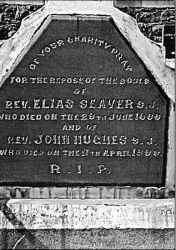
The presence of a Jesuit community at
Dromore (1884-88) is quietly remembered by this
gravestone in St. Colman's Cemetery.
We earlier mentioned the building of a new Episcopal
Palace by the Church of Ireland Bishops William Beresford and Thomas Percy in 1781/82. Bishop
Percy ensured, during his years there (17821811), that the grounds close
to the palace were richly planted and developed. The palace was occupied
afterwards by Bishop George Hall (1811-12), Bishop John Leslie (1812-19)
and Bishop James Saurin (1819-42). Following Bishop Saurin's death in
1842, the See of Dromore in the Church of Ireland was united with Down
and Connor. The palace became redundant and it and the demense were sold
by the Ecclesiastical Commissioners. The demense of 211 acres is said to
have previously been the property of the Magennis Family of Ballooley
House. The whole property was bought in 1846 by brothers Edward and
James Quinn. James, who served as a Justice of the Peace, occupied the
mansion for many years. It became known during this time as `Dromore
House'. James Quinn died on 1st. March 1883, according to a memorial in
his honour at the base of the tower of Dromore Cathedral. Later that
year `Dromore House' and the demense were sold by executors of the Quinn
estate and came into the possession of the Irish Province of the Jesuit
Order. How exactly this was achieved is uncertain. The Parish Priest of
Dromore at the time Monsignor William McCartan, was an enterprising,
widely known and well connected cleric. He claims, in a letter dated
1906 to the renowned Fr. William Ronan S.J. (held in the Jesuit archives
in Dublin), that he bought the property and brought the Jesuits there,
to bring "learning and sanctity" to the North. Whether he bought the
property out of his resources or simply on behalf of the Order, with
their resources, is unclear. (We noted, above, his apparently
substantial inheritance under the will of Anne Magennis of Ballooley
House.) Neither do we know whether he was directly involved in the
transactions or whether another party acted for him, or for the Jesuits.
What we can say is that the property was acquired at a cost of �8,200 in
1883, with a mortgage of �1,200 to the Ecclesiastical Commissioners. The
following year, 1884, it was opened as a House of Formation by the Irish
Jesuits on 3rd. May. The first group of novices arrived the next day.
Jesuit records of the years 1885-88 refer to the
house as "Domus Probationis Dromorensis" (the House of Formation at
Dromore). After occupying it, they changed the name from `Dromore House'
to `Loyola House,' after the Jesuit founder St. Ignatius of Loyola. The
first Rector of the House was Fr. William O'Farrell why, was
appointed on 4th. May 1884. He was assisted by Fr. John Colgan who was
appointed Vice-Rector on 15th. September 1885. Assisting him on the
staff, in 1888, were Fr. Denis Manning and Fr. John Hughes. Fr. Hughes
was reputed to be a gifted horticulturalist and a prizewinner at
important local shows. As it happened, he died at Dromore on 11th. April
1888 and is buried in the cemetery adjoining St. Colman's Church.
According to records available, in 1885 there was a total community of
20 at Loyola House. In 1886 the community totalled 23. It rose to 30 in
1887 and was 29 in 1888. The majority of the community over these years
would have been novices - prospective Jesuits in the very early stages
of training. They would have been accompanied by a small complement of
staff who would have been responsible for guiding them in their time of
discernment at the novitiate and directing their training. The period of
novitiate was two years, after which the candidate would take his First
Vows and then usually leave for university to undertake a primary degree
course. A small number of the novices at Dromore were priests, already
ordained, who were attempting, to discern if they were now being called
from their chosen ministry to become,Jesuits. In the novitiate, time
would have been shared between silent prayer, community
prayer and liturgy, spiritual reading and reflection, study, manual
labour, recreation and rest. A long walk, undertaken as a group, would
have occurred each week. One local story recalls how, at the time of
this weekly exercise, young ladies from the neighbourhood would gather
at a particular vantage point to eye the novices as they walked along a
path named `Purgatory Lane.'

Among those who were novices at Dromore over the years
1884-88 were Fr. Edmund Downing, who entered Dromore on 19th. September
1887. He died in Galway in 1933. Fr. James Rabbitte entered Dromore on
8th. September 1885. He died in Galway in 1940. Fr. Lambert McKenna
entered on 13th. September, 1886. He died in Dublin in 1956. Br. Edward
Mordaunt entered Dromore on 27th. April 1885. He died in Tullabeg in
1957. At least one novice died during his course of training at Dromore.
Elias Seaver, a scholastic, departed this life on 28th. June 1886 and
was buried in St. Colman's Cemetery, alongside Fr. Hughes.
The celebrated Jesuit priest-poet Gerard Manley
Hopkins visited Dromore on at least one occasion while the Jesuits were
there. Two of his sonnets `Tom's Garland' and `Harry Ploughman' were
signed by him "Dromore, 1887", indicating that he composed them while
staying at Loyola House sometime that year.
The Jesuit's stay at Dromore was to be, as it turned
out, rather short. By 1889, the Dromore novitiate is no longer mentioned
in the Jesuit Catalogue and a House of Studies and Formation is listed
at Tullamore, in King's County (Offaly). The aforementioned Fr. John
Colgan had been appointed its Rector on 2nd. September 1888. It would be
safe to presume that the Dromore novitiate ceased to function around the
summer of 1888. Why the Jesuits left Dromore so soon is not clear. One
strong suggestion is that they needed to occupy their large property at
Tullamore, as a boarding school previously operating there had
amalgamated with Clongowes Wood College in 1886 and had moved to its
premises in Kildare. With Jesuit properties in Kildare and in the Dublin
area, it may have seemed more practical to have the novitiate in the
southern half of the country. Whatever the reasons, Loyola House became
vacant and the Jesuit presence on the edge of Dromore town came to an
end.
The property at Dromore was, however, maintained by
the Jesuits for some years afterwards and the land continued to be
farmed there. Why they maintained the property for thirty years after
their departure is unclear. Perhaps they were glad to be able to accrue
revenue from it, over those years, while the land was being farmed. A
valuation was done in 1909 in which the valuer is said to have claimed
it to be the best farm he had ever inspected. Perhaps the Jesuits
intended to. make a return to Dromore, when circumstances were
favourable, and develop it as a base for ministry in the north of the
country. No return ever came to pass, however, and the house and lands
were eventually sold to the Wallace Family, on 22nd. January 1918, for
the sum of �8,840. Captain Thomas Herbert Wallace M.C., J.P, LL.B., his
wife and two daughters were the last residents of the original mansion.
In their day, it became known as `Bishopscourt'. After they left it, the
house became vacant for many years and fell into serious disrepair. It
was eventually demolished, some time after the Second World War. The
avenue to the house, from Upper Church Street on the edge of Dromore
town, was truncated by a new bypass road in the early 1970s.
(Sincere thanks to Mr. Henry Murray, Lurgan, for the
above information on the Jesuits in Dromore.)
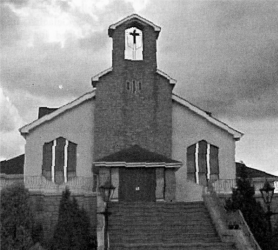
The new All Saints' Church was
built at Ballela, 1993-94. Inside one can see
`Stations of the Cross' transferred from the former
church, with their distinctive gaelic inscriptions.
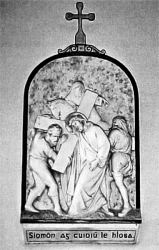
 |